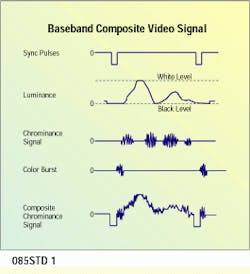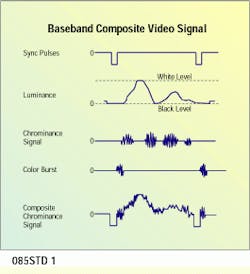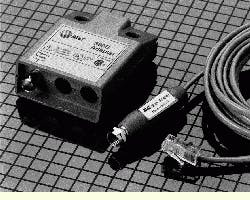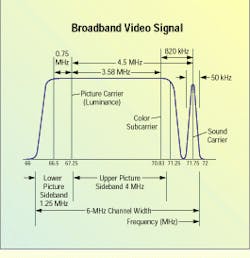Les A. Baxter, P.E.
William H. Georger
AT&T Bell Laboratories
Video represents a new kind of frontier for the use of unshielded twisted-pair cabling in what has traditionally been an application supported by coaxial cable. Video bandwidth requirements currently span a range from direct current to more than 750 megahertz. Unshielded twisted-pair cable can support much of this bandwidth, given recent technological advances in cable, media adapter and connector design. Opportunities abound in new and traditional areas for a single medium to support voice, data and video. Unshielded twisted-pair cable can now serve as a universal transmission medium, providing acceptable video quality and shared-sheath capability while offering easy entry into multimedia applications.
Recent advances in cable and media adapter technologies have made it possible to transmit analog baseband and broadband video signals over the same structured cabling systems that have supported voice and data signals. Distribution of analog baseband closed-circuit television and broadband community-antenna TV video signals over unshielded twisted-pair cabling can now be supported for applications in education, manufacturing, finance and medicine. Support of these analog video signals, in addition to voice and data, over unshielded twisted-pair cabling provides an easy and cost-effective means of supporting multimedia services that will soon be offered.
The major difference between analog and digital transmission is the way in which information contained in the video signal is conveyed. The analog signal is in the form of a continuous waveform that conveys video information via its magnitude and frequency. The digital signal uses discrete levels of a sequence of coded characters, represented as ones and zeros, to convey information.
Baseband video refers to a video signal that contains all the necessary information to reproduce a picture, without modulating radio-frequency channel carriers.
Composite video is baseband video signaling that forms a composite of the signal components needed to construct a monochrome or color picture. However, it contains no audio information. The integration of luminance, chrominance and color-burst signals with a synchronizing pulse results in one horizontal line of a color television picture. The chrominance and color-burst signals would be absent from a black-and-white picture. This type of video signal is typically the output of a video cassette recorder, laser disk player, camcorder or closed-circuit TV camera. The input/ output impedance of a baseband video connection is 75 ohms, unbalanced.
The bandwidth required to transmit a baseband video signal is between direct current and 8 MHz, depending on the video transmission format used. All three standard formats--NTSC, PAL and SECAM--are compatible in their processing of a monochrome picture, but they differ in their color-encoding techniques.
The National Television System Committee format was developed in the United States and was first broadcast in 1954. It uses 525 lines per frame at 30 frames per second; its bandwidth is 6 MHz. NTSC is the simplest video format to implement.
The Phase Alternate Line format was developed in Europe and was first broadcast in Germany and the United Kingdom in 1967. It uses 625 lines/ frame at 25 frames/second and has a bandwidth of 8 MHz. Although more robust than NTSC, it is also more difficult to implement.
The Sequential Couleur a Meinoire format was developed in France and first broadcast there in 1967. Like PAL, it supports 625 lines/frame at 25 frames/second and uses a bandwidth of 8 MHz. It is the most difficult of the formats to implement.
For these technologies, a standard baseband audio signal occupies a frequency band of 50 hertz to 15 kilohertz. Compact disk-quality audio extends this bandwidth from 10 Hz to 20 kHz. The input/output impedance of a baseband audio connection is 600 ohms, unbalanced.
Component video is another type of baseband video signal. Unlike composite video, where the chrominance signal represents a summation of the primary colors--red, green and blue--component video processes these primary colors individually. In addition, it separates them from the luminance signal. This is done to minimize the crosstalk that can occur between the two signals, which in turn enhances visual quality and permits higher resolutions to be achieved.
In broadband video, the radio-frequency carriers have been modulated by a composite baseband video and audio signal. Broadband video signals are transmitted and received using off-air (antenna), microwave (parabolic-dish) and cable equipment. The broadband video signal contains baseband video and audio information. The video data is luminance and chrominance information conveyed on an amplitude-modulated radio-frequency carrier; this carrier is located at 67.25 MHz for Channel 4. Audio information is sent on a frequency-modulated radio-frequency carrier located at 71.25 MHz for Channel 4.
Standard U.S. channel bandwidths, allocated by the Federal Communications Commission, are 6 MHz. Internationally, channel bandwidth varies between 6 and 8 MHz. A signaling format known as vestigial sideband is used to reduce the amount of spectrum space required for each channel. The number of supported cable channels is expected to increase as more fiber distribution hardware and digital technology are employed in cable-TV networks.
A cable-TV signal sent to a customer premises typically arrives via a cable feed supplied by the cable service provider. The cable-TV signal originates at a location known as the headend, where it has been amplified, filtered and adjusted for the proper modulation levels of the video and audio carriers. Once this signal enters the customer premises, it is amplified again and distributed by distribution amplifiers to directional couplers, splitters and distribution panels. It eventually arrives at the radio-frequency receiver of a TV or a set-top box.
The most important characteristic of the signal delivered to the TV receiver, besides its level, is its carrier-to-noise ratio. This ratio determines the degree to which the picture suffers such imperfections as snow or adjacent channel interference. Also known as beat noise, this interference can result in stationary horizontal lines running across the TV screen. The FCC recommends a minimum of 43 decibels of carrier-to-noise ratio beginning in 1995.
Opportunities abound for providers of structured cabling systems to support baseband and broadband analog video over unshielded twisted-pair cable for educational TV, closed-circuit security TV and community-antenna TV delivery. To support the demand for video in these applications, adequate technology in the form of media adapters (video baluns), input/output connectors and unshielded twisted-pair cabling must exist.
The ability of these structured cabling components to provide adequate balance, maximize return loss, minimize attenuation and introduce a high level of common-mode rejection becomes essential when attempting to support the high-frequency demands of broadband video. Baseband video, although occupying a narrower bandwidth than broadband, requires the same component performance, if not more, for adequate transmission over unshielded twisted-pair cabling. This is because the information contained in the baseband signal is directly affected by the performance of each component, unlike the case with the broadband signal, which contains baseband information but transmits it via amplitude- and frequency-modulated carriers. In a broadband system, all that is required is detection of the modulated carriers by the receiving equipment. The carriers are then removed, leaving the original information intact--and virtually unaffected by the cabling components.
A typical educational application includes selectable delivery of baseband video services such as video cassette recorder and satellite receiver via a matrix switch that routes services using a pair of video media adapters and Category 3 or Category 5 unshielded twisted-pair cabling. An analog telephone can share the work-location input/output and can be used for voice or to send dual-tone, multiple-frequency signaling back to the matrix switch for control purposes.
A representative security application includes a standard closed-circuit TV camera located in a remote location within a building and attached to a pan/tilt/zoom control unit. Video media adapters not only permit transmission of baseband composite video from the camera to travel over unshielded twisted-pair cable, but they also allow the video signal to share the cable sheath with pan/tilt/zoom control signals. These signals are typically in balanced Electronic Industries Association-232, EIA-422, 24-volt AC or Manchester format. They travel via the structured cabling system to a controllable matrix switch that links several television monitors in a security video equipment room.
A community-antenna television delivery application may consist of a headend located on the first floor of a building. The headend serves as the cable-TV processing center that receives multichannel programming via cable drop, antenna, microwave or satellite receiver. At present, coaxial cable can adequately serve the riser/backbone subsystem of the building, with unshielded twisted-pair cabling serving in the horizontal subsystem.
Structured cabling offers ease of design for cable-TV installers. All the installer needs to know is the loss as a function of frequency for the broadband media adapters and the unshielded twisted-pair cable. A broadband distribution amplifier can be located in a telecommunications closet serving a floor. The amplifier provides gain and equalization needed to compensate for signal attenuation and tilt caused by splitters, couplers, media adapters and cables, while it introduces minimal distortion to the system. Category 5 cabling, exhibiting superior attenuation, structural return loss, near-end crosstalk and balance performance, can be used for this application.
A baseband composite video signal is composed of several signals superimposed on each other.
These baseband and broadband video media adapters demonstrate that not all equipment associated with broadcasting is large, heavy and bulky.
A broadband video signal, such as this one for Channel 4, uses separate radio-frequency carriers to carry video and audio information.
Les A. Baxter is director of technology and William H. Georger is a member of the technical staff at AT&T Bell Laboratories, Middletown, NJ.



